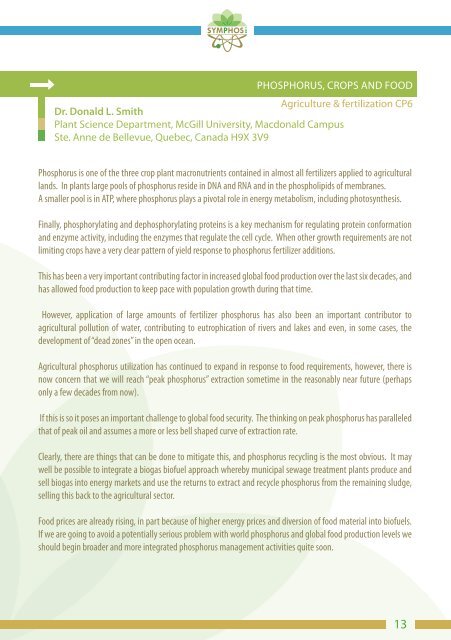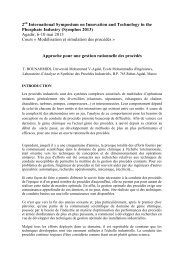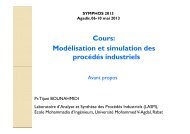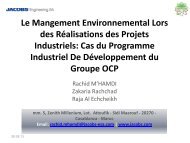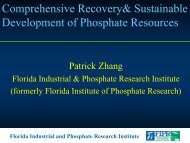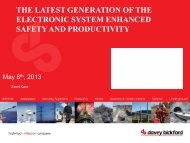Abstract SYMPHOS 2011
Abstract SYMPHOS 2011
Abstract SYMPHOS 2011
Create successful ePaper yourself
Turn your PDF publications into a flip-book with our unique Google optimized e-Paper software.
PHOSPHORUS, CROPS AND FOOD<br />
Agriculture & fertilization CP6<br />
Dr. Donald L. Smith<br />
Plant Science Department, McGill University, Macdonald Campus<br />
Ste. Anne de Bellevue, Quebec, Canada H9X 3V9<br />
Phosphorus is one of the three crop plant macronutrients contained in almost all fertilizers applied to agricultural<br />
lands. In plants large pools of phosphorus reside in DNA and RNA and in the phospholipids of membranes.<br />
A smaller pool is in ATP, where phosphorus plays a pivotal role in energy metabolism, including photosynthesis.<br />
Finally, phosphorylating and dephosphorylating proteins is a key mechanism for regulating protein conformation<br />
and enzyme activity, including the enzymes that regulate the cell cycle. When other growth requirements are not<br />
limiting crops have a very clear pattern of yield response to phosphorus fertilizer additions.<br />
This has been a very important contributing factor in increased global food production over the last six decades, and<br />
has allowed food production to keep pace with population growth during that time.<br />
However, application of large amounts of fertilizer phosphorus has also been an important contributor to<br />
agricultural pollution of water, contributing to eutrophication of rivers and lakes and even, in some cases, the<br />
development of “dead zones” in the open ocean.<br />
Agricultural phosphorus utilization has continued to expand in response to food requirements, however, there is<br />
now concern that we will reach “peak phosphorus” extraction sometime in the reasonably near future (perhaps<br />
only a few decades from now).<br />
If this is so it poses an important challenge to global food security. The thinking on peak phosphorus has paralleled<br />
that of peak oil and assumes a more or less bell shaped curve of extraction rate.<br />
Clearly, there are things that can be done to mitigate this, and phosphorus recycling is the most obvious. It may<br />
well be possible to integrate a biogas biofuel approach whereby municipal sewage treatment plants produce and<br />
sell biogas into energy markets and use the returns to extract and recycle phosphorus from the remaining sludge,<br />
selling this back to the agricultural sector.<br />
Food prices are already rising, in part because of higher energy prices and diversion of food material into biofuels.<br />
If we are going to avoid a potentially serious problem with world phosphorus and global food production levels we<br />
should begin broader and more integrated phosphorus management activities quite soon.<br />
13


